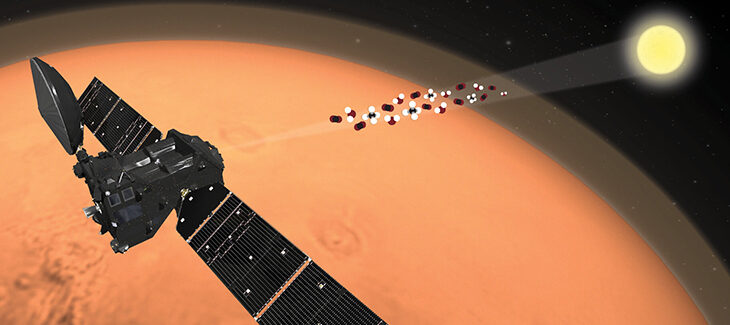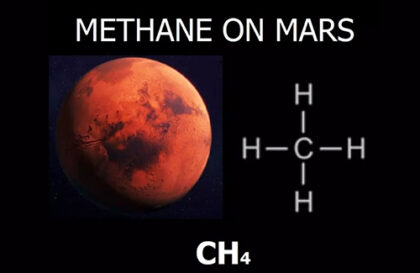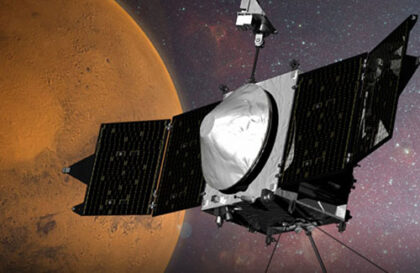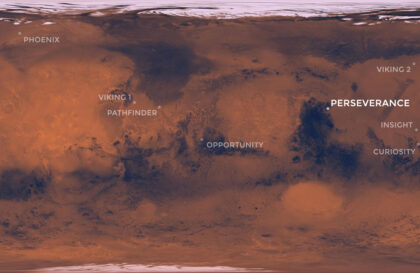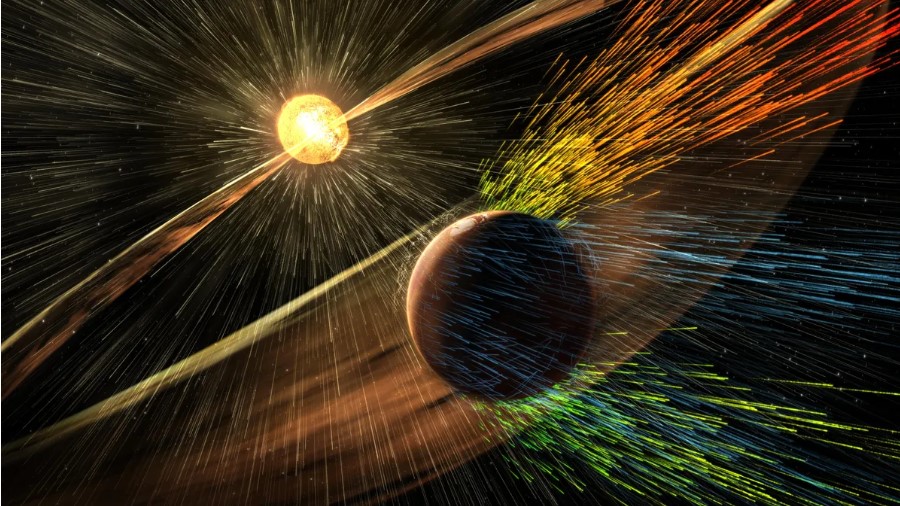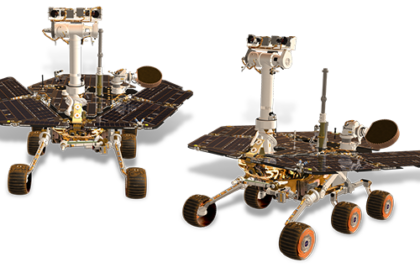Although the Martian atmosphere is composed mostly of carbon dioxide, TGO analyzes its trace gases, such as water vapor and methane, which make up less than 1% of the atmosphere’s volume. Despite their small quantities, these gases are key to understanding the history of water on Mars and identifying active processes on its surface today. Methane is especially important because of its connections to geological and biological processes.
The ExoMars Trace Gas Orbiter (TGO), a project of ESA and Roscosmos, arrived on Mars in October 2016 and, using aerobraking techniques, entered a scientific orbit at an altitude of 400 km a year later. TGO’s primary mission, which began in April 2018, monitored the development of a global dust storm that ultimately led to the end of NASA’s Opportunity rover mission. TGO studied how the dust storm affected water vapor in the Martian atmosphere, which contributes to understanding the history of water on the planet.
The dust storm helped
AN ARTIST’S DEPICTION OF AN APPROACHING DUST STORM ON MARS, 1976 Artist Ludek Pesek used information and images gathered by spacecraft to depict the landscape and atmosphere of Mars. Credit: Mars, Ludek Pesek
The spacecraft’s onboard NOMAD and ACS spectrometers took measurements of the solar eclipse in the Martian atmosphere, examining the absorption of sunlight to analyze chemical composition. This made it possible to study the vertical distribution of water vapor and “semi-heavy” water from the Martian surface to 80 km altitude, as well as to trace how dust and water interact in the atmosphere and how hydrogen atoms escape into space.
During the dust storm, the amount of water vapor in the Martian atmosphere rapidly increased, indicating its active response to meteorological phenomena.
This phenomenon is consistent with global circulation models: dust absorbs sunlight, heating the gas, causing it to expand and redistribute water and other elements. The temperature contrast between the equator and the poles also increases and, at higher temperatures, fewer of the water-ice clouds that typically trap water vapor in the lower atmosphere form.
Teams of scientists have observed semi-heavy water and water vapor simultaneously for the first time, providing evidence of the processes that control the leakage of hydrogen and deuterium into space, and determining the deuterium-to-hydrogen (D/H) ratio important to the evolution of Mars’ water reserves.
Water, deuterated or not, reacts to the presence of ice clouds by preventing it from rising higher in the atmosphere, but during a storm the water reaches greater heights.
There is methane on Mars. But how much?
Interest in methane stems from the fact that it may be a sign of life. For example, 95% of the methane in the Earth’s atmosphere comes from biological processes. Methane can be destroyed by solar radiation over several hundred years, so any discovery of the molecule at this time suggests it must have been released relatively recently.
Two instruments have begun measuring trace gases in the Martian atmosphere, which make up less than 1% of its volume and require precise measurement techniques to detect their chemical traces. Impurities are usually measured in “parts per billion by volume” (ppbv), for example, the Earth’s methane reserves are 1,800 ppbv, meaning that for every billion molecules, 1,800 are methane.
ESA’s Mars Express probe made one of the first measurements of methane from orbit in 2004. Measurements showed methane at 10 parts per billion by volume.
Ground-based telescopes also reported methane at levels of about 45 parts per billion by volume. NASA’s Curiosity rover, which has been exploring Gale Crater since 2012, suggested that background methane levels vary seasonally from 0.2 to 0.7 parts per billion, with some spikes at higher levels. Mars Express also observed a spike in methane the day after one of Curiosity’s highest readings.
Credit: NASA/JPL-Caltech
The new TGO results represent the most detailed global analysis yet, finding an upper limit of 0.05 parts per billion, 10 to 100 times less methane than all previous reported detections. The most accurate detection limit of 0.012 ppb was achieved at an altitude of 3 km.
In any case, this is an extremely low figure.
There was water on Mars. That’s for sure.
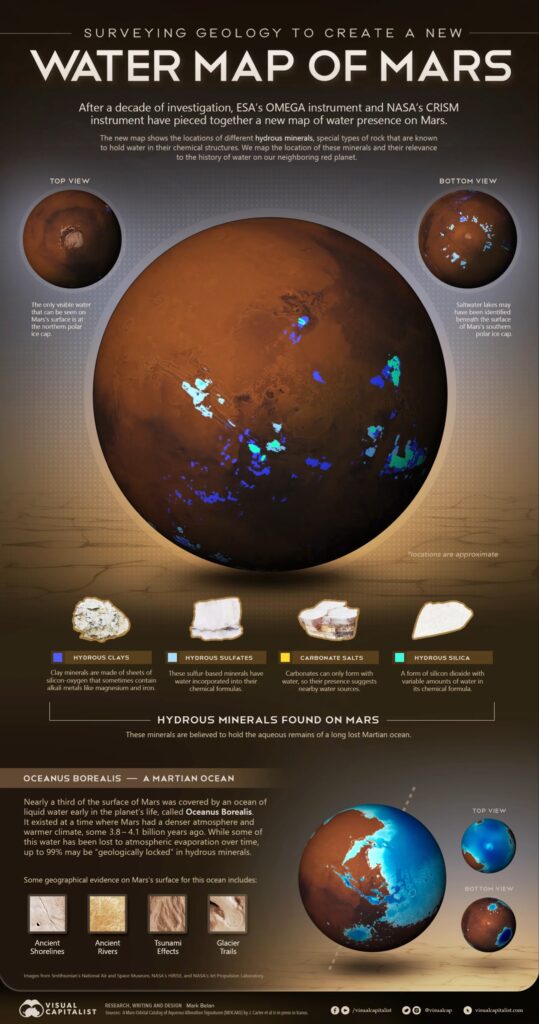
Credit: visualcapitalist
The FREND neutron detector on board TGO is studying the distribution of hydrogen in the upper surface layer of Mars, indicating the possible presence of water or water-hydrated minerals and helping to understand the history of water on the planet, where life could potentially exist. Although complete mapping will take about two Earth years, the first maps produced in a few months have already surpassed the resolution of 16 years of data from the instrument’s predecessor aboard NASA’s Mars Odyssey.
The new map of water on Mars, in addition to identifying the water-intensive polar regions, provides detailed information about the planet’s “wet” and “dry” areas, also identifying areas of high water content in the equatorial regions, which may indicate existing permafrost or the planet’s former poles.
Banner image: ESA/ATG medialab
Image credit:
https://www.esa.int
https://www.planetary.org
https://mars.nasa.gov
https://www.visualcapitalist.com
